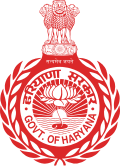Coat of arms of India
The Indian Emblem of India is the symbol of the Republic of India, formally called 'National emblem'. It has four lions. The idea for this coat of arms was taken from the Sarnath Lion Capital that was built by Indian emperor Ashoka. It's a pillar in the city of Sarnath. Ashoka built it around 250 BC using a single piece of polished sandstone. The symbol is invariably used on all types of currency notes, passports and coins of India. In the two dimensional view of this symbol, one can see 3 heads (the fourth being hidden from view). It was adopted on 26 January 1950, the day that India became a republic.[1]
The lions represent royalty and pride. It also represents the currency.
The wheel beneath the lions is called the Ashoka Chakra or Dharmachakra comes from Buddhism, representing Truth and Honesty. The horse and the bull probably stand for the Strength (Mental) of the people of India. There are four Ashoka Chakras in total around the emblem and two horses and bulls each.
The verse written below, Satyamev Jayate is a very popular and revered saying in the ancient language Sanskrit. It can be divided phonetically into three words - Satyam, which means truth, Ev or aev, that is, only and Jayate which means wins or won. The whole verse can be translated as, 'Only (the one who speaks) the truth will win or wins.' This verse describes the power of honesty and truth in society and religion. You can lie to your friends, family, but you cannot lie to God and yourself. Your conscience will forever be stained.
The verse can also be translated as 'The truth alone triumphs'. Meaning that even after all the lies and deceptions with which we have been fooled, the truth will finally emerge victorious.
Coat Of Arms Of India Media
The original Lion Capital of Ashoka, 3rd century BCE, Sarnath Museum
- Emblem of Andhra Pradesh.svg
Emblem of Andhra Pradesh
References
- ↑ "State Emblem". Know India. Government of India. Archived from the original on 25 December 2018. Retrieved 1 May 2016.









